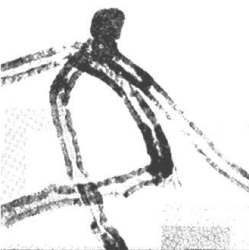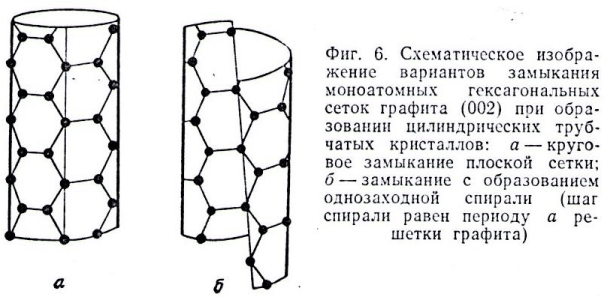International Journal of Nanomaterials, Nanotechnology and Nanomedicine
Credit to pioneering work on carbon nanotubes
Eugene A Katz1,2*
2Ilse-Katz Institute for Nanoscale Science and Technology, Ben-Gurion University of the Negev, Beer Sheva 84105, Israel
Cite this as
Katz EA (2021) Credit to pioneering work on carbon nanotubes. Int J Nanomater Nanotechnol Nanomed 7(1): 043-044. DOI: 10.17352/2455-3492.000044Summary
This letter gives a credit to a pioneering paper by A. M. Nesterenko, et al. (Izvestia Akademii Nauk SSSR, Met. 1982, [in Russian]) that is almost unknown to scientific community. On the basis of Transmission Electron Microscopy images and X-ray Ray Diffraction patterns of “carbon multi-layer tubular crystals” the authors suggested a model of nanotube structure formation and hypothesis on various chirality of carbon nanotubes.
The history of discovery of Carbon Nanotube (CNT) is repeatedly discussed [1]. Among other CNT pioneers, a credit is given to Russian physical chemists L. V. Radushkevich and V. M. Lukyanovich who, in 1952 in Russian Journal of Physical Chemistry, published clear Transmission Electron Microscopy (TEM) images of 50 nanometer diameter carbon tubes (Multi-Walled CNT in modern terminology) synthesized by a thermocatalytical disproportionation of carbon monoxide [2].
However, one important pioneering work has not been given a credit as yet.
In 1982 (nine years before publication of the famous Iijima’s paper [3] (1991)] the group of Ukrainian scientists published in Russian the results of chemical and structural characterization of carbon nanoparticles also produced by a thermocatalytical disproportionation of carbon monoxide [4].
The authors not only demonstrated TEM images of carbon nanotubes with hollow channels and the catalyst particles connected to one end of the tubes (Figure 1) but analyzing the X-ray diffraction (XRD) data suggested that their “carbon multi-layer tubular crystals” were formed by rolling graphene layers into cylindrical tubes. It should be noted that similar conclusion was reached in a previous publication as well [5]. It differs this study from other early publications on manufacturing carbon filaments [6-8].
However, the authors of ref. 4 understood that such a rolling requires a circuit of hexagonal carbon nets of graphene into a cylinder without “seams”. This was the first ever-published model of CNT structure formation. Furthermore (!), the authors formulated a conjecture on chirality of nanotubes. They speculated that during such rolling graphene layers into a cylinder, many different arrangements of graphene hexagonal nets are possible. They suggested two possibilities of such arrangements (Figure 2): circular arrangement (armchair nanotube in the nowadays terminology) and a spiral, helical arrangement (chiral tube).
Unfortunately, to date, this article is almost unknown to scientific community. This pioneering work should get an international credit and be returned to the history of science.
- Monthioux M, Kuznetsov V (2006) Who should be given the credit for the discovery of carbon nanotubes? Carbon 44: 1621-1623. Link: https://bit.ly/2RUugky
- Radushkevich LV, Lukyanovich VM (1952) O strukture ugleroda, obrazujucegosja pri termiceskom razlozenii okisi ugleroda na zeleznom kontakte. Zurn Fisic Chim 26: 88–95.
- Iijima S (1991) Helical microtubules of graphite carbon. Nature 354: 56–58. Link: https://go.nature.com/3eTxSfS
- Nesterenko AM, Kolesnik NF, Akhmatov YuS, Suhomlin VI, Prilutskii OV (1982) Osobennosti fazovogo sostava i struktury produktov vzaimodeistviya NiO i Fe2O3 s okis’yu ugleroda. Izvestia Akademii Nauk SSSR, Seriya Metally 3: 12-17.
- Hillert M, Lange N (1959) The structure of graphite filaments. Zeitschrift für Kristallographie 111: 24-34. Link: https://bit.ly/2SQdTpv
- Hughes TV, Chambers CR (1889) Manufacture of Carbon Filaments. US Patent (405480). .
- Schützenberger P, Schützenberger LCR (1890) Sur quelques faits relatifs à l'histoire du carbone. Acad Sci Paris 111: 774-778.
- Pélabon C, Pélabon HCR (1903) Sur une variétë de carbone filamenteux. Acad Sci Paris 137: 706-708.

Article Alerts
Subscribe to our articles alerts and stay tuned.
 This work is licensed under a Creative Commons Attribution 4.0 International License.
This work is licensed under a Creative Commons Attribution 4.0 International License.


 Save to Mendeley
Save to Mendeley
